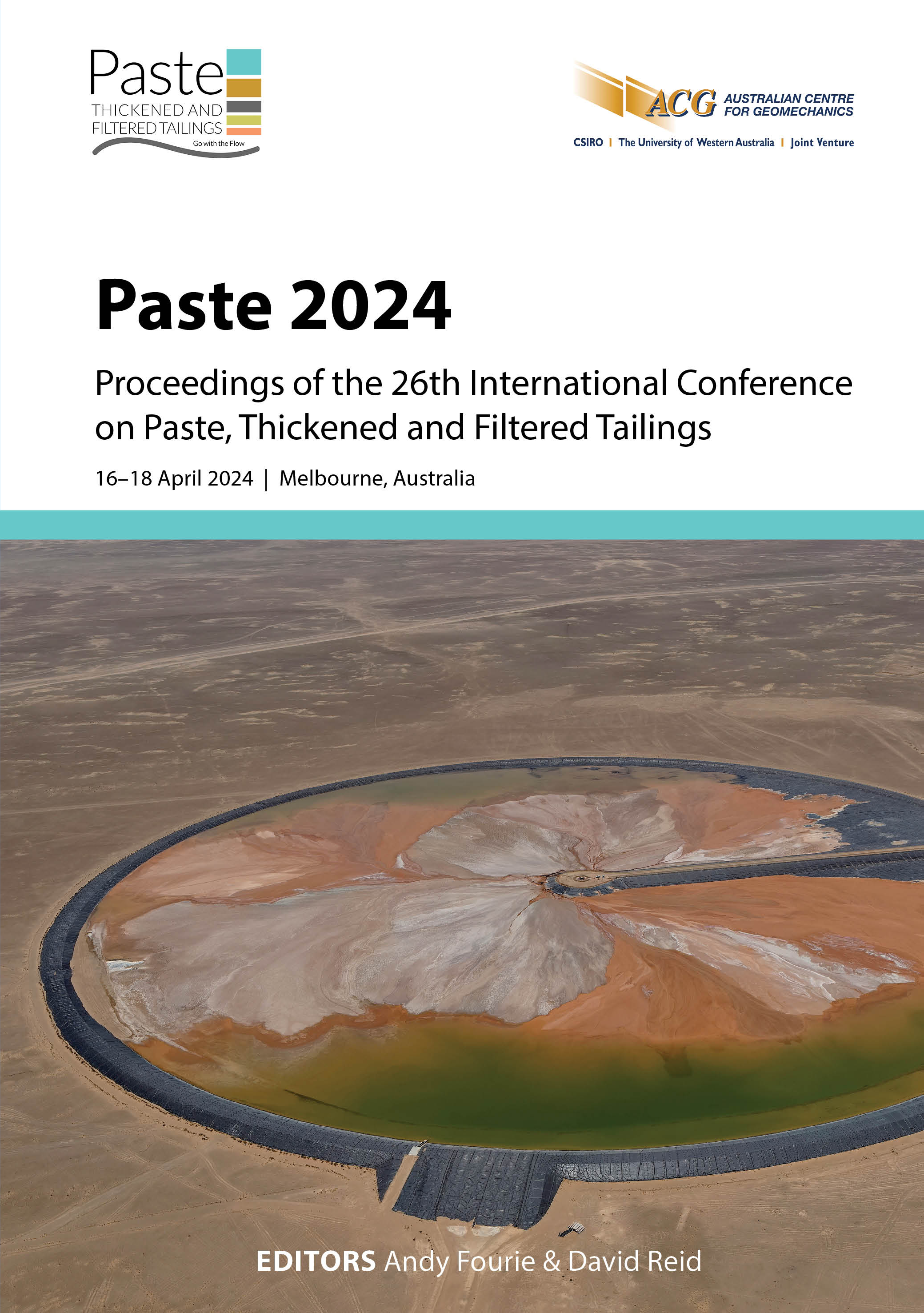Crushed rock-thickened tailings pumping at ultra-high concentrations

|
Authors: Wennberg, T; Stålnacke, A; Sellgren, A |
DOI https://doi.org/10.36487/ACG_repo/2455_33
Cite As:
Wennberg, T, Stålnacke, A & Sellgren, A 2024, 'Crushed rock-thickened tailings pumping at ultra-high concentrations', in AB Fourie & D Reid (eds), Paste 2024: Proceedings of the 26th International Conference on Paste, Thickened and Filtered Tailings, Australian Centre for Geomechanics, Perth, pp. 421-430, https://doi.org/10.36487/ACG_repo/2455_33
Abstract:
At the LKAB underground mines in northern Sweden, crushing a portion of the rock to less than 30 mm is already part of the surface processing and an interesting alternative for co-disposal. Long-term plans may also include use of backfilling which requires flexibility with respect to tailings availability. The overall objective here is to investigate the system’s feasibility of pumping paste-rock mixtures with particle sizes of up to about 30 mm at ultra-high concentrations. Initially, it is a limited distance for co-disposal in nearby old pit holes and depressions. In a wider perspective, it is a possible site-specific complement or alternative to filtration in systems for tailings storage or cut-and-fill mining with paste aggregate. Indicative tests were carried out in a 94 m long loop with a 0.15 m diameter pipeline for mass rock to paste ratios (R:P) of 1.2:1 up to 4.9:1 at solids concentrations by weight (Cw) of up to 89% corresponding to a water content of 12%. The test was carried out at a paste thickener with direct access to fresh paste and mixed with crushed rock from the processing. A concrete mixer truck was used for the blending before pumping. A laboratory-scale concrete industry device was also used, the sliding pipe rheometer, ‘Sliper’, developed to simulate concrete pipeline pumping frictional resistance in a 0.126 m diameter pipeline with length 0.5 m adopted vertically. The result agreed well with the pipeline pressure gradients if extrapolated to some larger flow rates. An inverse pipeline diameter dependence on friction losses was confirmed. The pressure requirement loop results were within 10 to 23 kPa/m for velocities from 0.7 to 1.4 m/s for solids concentrations by weight of 87 to 89% with R:P from 3.8:1 to 4.9:1. The corresponding concentrations by volume were 70 and 74% with water contents of about 15 and 12%, respectively. Solids density 2,900 kg/m3. At Cw values from 77 to 85% the resulting pressure gradients were from about 3 to 7 kPa/m with water contents exceeding 18%. The R:P values 3.8:1 and 4.9:1 mean that the coarse particles take up 75 to 80% of the volume combining coarse particle related frictional resistance with a near wall viscous contribution through silica flour slurry. Dependent on the availability of paste and function of the mixing and feeding arrangements a disturbance was simulated for pumping with only coarse particles for fully stratified flow friction loss conditions.
Keywords: paste-rock pumping, loop test, ultra-high concentration, particle stratification
References:
Feys, D, Shutter, GD, Fataei, S, Martys, NS & Mechtcherine, V 2022, ‘Pumping of concretes: understanding a common placement method with lots of challenges’, Cement and Concrete Research, vol. 154, pp. 1–17.
Kaplan, D, Larrard, F & Sedran, T 2005, ‘Design of concrete pumping circuits’, ACI Materials Journal, vol. 102, no. 2, pp. 110–117.
Kasten, K 2010, Gleitrohr Rheometer, Ein Verfahren zur Bestimmung der von Flieseigenshaften Dickstoffen in Rohrleitungen (The Sliding Pipe Rheometer, Flow Characteristics of Highly Viscous Materials), PhD thesis, Technische Universität, Dresden.
Matoušek, V, Visintainer, R, Furlan, J & Sellgren, A 2020, ‘Pipe-size scale-up of frictional head loss in settling-slurry flows using predictive models: experimental validation’, ASME Fluids Engineering Division Summer Meeting, The American Society of Mechanical Engineers, Houston.
Mechtcherine, V, Nerella, V & Kasten, K 2014, ‘Testing pumpability of concrete using Sliding Pipe Rheometer’, Construction and Building Materials, vol. 53, no. 28, pp. 312–323,
Pullum, L 2007, ‘Pipelining tailings, pastes and backfill’, in R Jewell & AB Fourie (eds), Paste 2007: Proceedings of the Tenth International Seminar on Paste and Thickened Tailings, Australian Centre for Geomechanics, Perth, pp. 113–127.
Pullum, L, McCarthy, D & Longworth, N 1996, ‘Operating experiences with a rotary ram slurry pump to transport ultrahigh concentration coarse suspensions’, BHR Group Conference Series Publication, vol. 20, pp. 657–672.
Secrieru, E, Fataei, S, Schröfl, C & Mechtcherine, V 2017, ´Study on concrete pumpability combining different laboratory tools and linkage to rheology’, Construction and Building Materials, vol. 144, pp. 451–461.
j.conbuildmat.2017.03.199
Visintainer, R, Matousek, V, Pullum, L & Sellgren, A 2023, ‘Introduction’, Slurry Transport Using Centrifugal Pumps, 4th edn, Springer Nature Switzerland, Cham.
Wennberg, T, Stalnacke, A & Sellgren, A 2020, ‘Commission and operation experiences of two thickened tailings facilities’,
in H Quelopana (ed.), Paste 2020: 23rd International Conference on Paste, Thickened and Filtered Tailings, Gecamin Publications, Santiago,
Wennberg, T, Stålnacke, A & Sellgren, A 2023, ‘Loop pumping tests of crushed rock mixed with thickened tailings’, in GW Wilson, NA Beier, DC Sego, AB Fourie & D Reid (eds), Paste 2023: Proceedings of the 25th International Conference on Paste, Thickened and Filtered Tailings, University of Alberta, Edmonton, and Australian Centre for Geomechanics, Perth,
Wickland, BE 2006, Volume Change and Permeability of Mixtures of Waste Rock and Fine Tailings, PhD thesis, University of British Columbia, Vancouver.
Wilson, C & Addie, G 1995, ‘Coarse-particle pipeline transport: effect of particle degradation on friction’, Proceedings of the 8th International Freight Pipeline Society Symposium, University of Pittsburg, Pittsburg, pp. 151–156.
Wilson, GW, Miskolczi, J, Dagenais, AM, Smith, Q, Lanteigne, L, Hulett, L & Landriault, D 2006, ‘The Application of ‘Paste Rock’ for Cover Systems in Mine Waste Management’, in R Jewell, S Lawson & P Newman (eds), Paste 2006: Proceedings of the Ninth International Seminar on Paste and Thickened Tailings, Australian Centre for Geomechanics, Perth, pp. 209–219,
© Copyright 2025, Australian Centre for Geomechanics (ACG), The University of Western Australia. All rights reserved.
View copyright/legal information
Please direct any queries or error reports to repository-acg@uwa.edu.au
View copyright/legal information
Please direct any queries or error reports to repository-acg@uwa.edu.au
